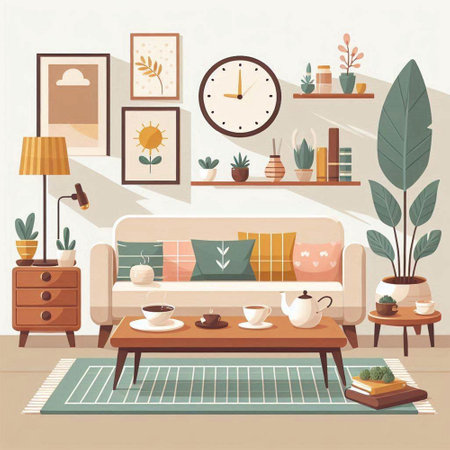Introduction to Interior Design in the UK
The interior design profession in the United Kingdom carries a distinctive legacy, blending deep-rooted historical influences with contemporary innovation. Tracing its origins back to the ornate grandeur of Georgian and Victorian eras, British interior design has long been associated with elegance, craftsmanship, and a nuanced sense of place. Over time, these traditions have evolved, giving rise to today’s vibrant industry where modern British designers balance heritage motifs with cutting-edge trends such as sustainable materials and open-plan living. In the UK context, the path to becoming an interior designer is shaped by both creative exploration and regulatory frameworks. Although there is currently no statutory requirement for formal registration or certification, professional standards are maintained through voluntary accreditation with bodies like the British Institute of Interior Design (BIID). This legal landscape encourages aspiring designers to pursue rigorous education and practical experience, ensuring that their work not only reflects personal flair but also adheres to safety and ethical guidelines. As such, understanding both the cultural evolution and the regulatory environment is essential for anyone considering a career in UK interior design.
2. Educational Pathways and Accreditation
Embarking on a career as a certified interior designer in the UK requires navigating a well-defined educational journey, with pathways rooted in British academic tradition and professional accreditation. The process is guided by respected bodies such as the British Institute of Interior Design (BIID), ensuring that your qualifications are recognised both nationally and internationally.
The Importance of Accredited Programmes
In the UK, obtaining an education from a BIID-accredited institution is a crucial step. Accreditation guarantees that your studies meet industry standards, providing you with up-to-date knowledge and practical skills valued by employers and clients alike. Many employers specifically seek graduates from these programmes, making accreditation a non-negotiable element for those aspiring to professionalism.
Recommended Academic Routes
There are several academic routes available to prospective interior designers. While some may begin with foundational courses or diplomas, most professionals pursue undergraduate degrees followed by specialised postgraduate study or certification. Below is an overview of the most respected options:
| Academic Route | Typical Qualification | Duration | Accredited Institutions |
|---|---|---|---|
| Bachelor’s Degree | BA (Hons) Interior Design / Interior Architecture | 3 years (full-time) | University of the Arts London, Glasgow School of Art, Manchester Metropolitan University, etc. |
| Foundation Diploma | Foundation Diploma in Art & Design (with Interior Design specialism) | 1 year | Chelsea College of Arts, Central Saint Martins, etc. |
| Postgraduate Study | MA/MSc in Interior Design or related field | 1 year (full-time) | Kings College London, Royal College of Art, Edinburgh College of Art, etc. |
| Professional Certification | BIID Registered Interior Designer Status NCIDQ Certificate CPD Courses (Continuing Professional Development) |
Varies (usually after degree completion) | British Institute of Interior Design (BIID), RIBA-approved providers, etc. |
Selecting the Right Institution and Course
Your choice of institution plays a significant role in shaping your design philosophy and future opportunities. Leading universities and colleges offer diverse specialisms, studio-based learning, and direct links to industry professionals through placements and live projects. Consider researching course content thoroughly—look for modules in spatial planning, sustainable design, history of interiors, and digital visualisation, which are highly valued within the British context.
Navigating Entry Requirements
Most undergraduate programmes require A-levels or equivalent qualifications (such as BTECs or Scottish Highers), preferably in art, design, or related subjects. Portfolio submissions are standard practice; showcasing your creative abilities through sketches, models, and previous project work is essential. For postgraduate routes, relevant undergraduate degrees and demonstrable experience are typically required.
The Value of Professional Memberships
Pursuing student membership with the BIID or similar bodies during your studies grants access to exclusive networking events, mentorship schemes, and industry resources. These memberships not only enhance your CV but also immerse you in Britain’s vibrant interior design community from the outset.

3. Gaining Practical Experience
The Cornerstone: Internships, Apprenticeships, and Studio Placements
No step towards becoming a certified interior designer in the UK is quite as pivotal as gaining hands-on experience. While theoretical knowledge lays the groundwork, it is through internships, apprenticeships, and placements that aspiring designers truly come to grips with the real-world demands of the industry. UK design studios are renowned for their dynamic work environments, often blending heritage aesthetics with contemporary trends. Immersing yourself in these settings not only provides valuable technical skills but also helps you understand what British clients look for—whether its sensitivity to period properties, eco-conscious solutions, or familiarity with local suppliers and regulations.
Why UK Experience Matters
British interior design culture values both innovation and respect for context. Employers and clients alike expect new designers to appreciate architectural history, spatial constraints typical of UK homes, and even nuances like planning permissions. Completing a placement in a London townhouse restoration or working on a sustainable fit-out in Manchester can set your portfolio apart from those with purely academic experience.
Building a Portfolio That Resonates Locally
Your portfolio is your professional calling card. In the UK, curating a portfolio means more than showcasing technical prowess; it’s about demonstrating adaptability to British tastes and standards. Include projects that reflect an understanding of local materials (think Cotswold stone or London brick), compliance with building regulations, and awareness of national design trends such as biophilic interiors or maximalist décor. Document your role in collaborative studio projects, highlight before-and-after transformations, and provide brief narratives explaining how each project met client needs within the UK context.
Networking and Industry Connections
Finally, remember that placements are prime opportunities to forge lasting relationships within the British design scene. Attending trade shows like Decorex International or joining professional bodies such as the British Institute of Interior Design (BIID) can help cement your reputation and keep you attuned to evolving cultural preferences. A robust network and locally relevant experience will give you a significant edge as you move forward in your certification journey.
4. Professional Registration and Memberships
After establishing your educational foundation and practical experience, the next pivotal step in becoming a certified interior designer in the UK is professional registration and joining relevant associations. This process not only enhances your credibility but also connects you with a wider network of professionals and clients within the British design industry.
Registering with Regulatory Bodies: The BIID
The British Institute of Interior Design (BIID) is the foremost professional body for interior designers in the UK. Registration with the BIID signifies adherence to rigorous standards and a commitment to ethical practice. To become a BIID Registered Interior Designer®, candidates must demonstrate both qualifications and practical experience, as well as successfully complete an assessment process that evaluates their competence and professionalism.
BIID Registration Requirements
| Requirement | Description |
|---|---|
| Accredited Qualification | A recognised degree or diploma in interior design or a related field |
| Professional Experience | Minimum of 6 years’ combined education and work experience |
| Portfolio Submission | Comprehensive portfolio demonstrating project work and skills |
| Professional Assessment | Interview or review by BIID panel assessing readiness for registration |
| CPD Commitment | Ongoing Continuing Professional Development (CPD) activities each year |
The Benefits of Joining UK-Based Professional Associations
Membership in bodies such as the BIID, Society of British & International Interior Design (SBID), and Chartered Society of Designers (CSD) offers a suite of tangible benefits tailored to the UK context:
- Industry Recognition: Membership signals professionalism and quality assurance to clients, suppliers, and peers.
- Access to Resources: Exclusive access to British standards, research, events, and training opportunities.
- Networking: Regular opportunities to engage with leading UK designers and participate in sector-specific forums and exhibitions.
- Legal Support: Guidance on contract law, copyright issues, and dispute resolution relevant to UK legislation.
- PQAs & CPD: Structured support for maintaining Professional Qualifications Awards (PQAs) and CPD compliance within the UK framework.
Cultural Considerations for UK Designers
The UK’s regulatory environment places significant emphasis on sustainability, inclusivity, and heritage conservation. Joining British professional bodies helps ensure your practice aligns with these cultural priorities—whether you are designing period properties in London or contemporary spaces in Manchester. Members receive updates on planning regulations, health & safety standards, and guidance on integrating local craftsmanship into projects—a distinct advantage for those seeking long-term success in the British market.
5. Navigating Regulatory Standards and Ethics
In the UK, interior designers are expected to operate within a robust framework of regulations, codes of practice, and ethical guidelines. Understanding these standards is crucial for anyone aspiring to become a certified interior designer. Unlike some countries where interior design is tightly legislated, the UK’s approach blends statutory requirements with professional best practices, ensuring both creative freedom and public safety.
Understanding British Interior Design Regulations
The foundation of regulatory compliance in British interior design rests upon building regulations and planning permissions. These are administered primarily through local authorities and set clear criteria regarding fire safety, accessibility, ventilation, and energy efficiency. For example, adherence to the Building Regulations 2010 is mandatory when making alterations to structural layouts or services such as electrics and plumbing. Designers must also be familiar with listed building consent processes if working with heritage properties—a uniquely British concern that reflects the nation’s respect for architectural history.
Codes of Practice: Professional Bodies and Accreditation
Professional bodies like the British Institute of Interior Design (BIID) play a pivotal role in shaping industry standards. Membership often signals a designer’s commitment to ongoing professional development and ethical conduct. BIID’s Code of Conduct covers client relationships, confidentiality, fair business practices, and intellectual property rights. It also encourages designers to maintain transparent communication with clients—an essential aspect in the UK’s service-oriented culture.
Ethical Frameworks: Client Relations, Safety, and Sustainability
A hallmark of British interior design professionalism is an unwavering commitment to ethics. Designers are expected to prioritise client welfare, ensuring that all projects comply with health and safety legislation such as the Health and Safety at Work Act 1974. Furthermore, sustainability has become integral: practitioners must consider material sourcing, waste reduction, and energy conservation—key values in contemporary British society. Upholding these principles not only meets legal obligations but also aligns with the growing demand for responsible design solutions among UK clients.
Navigating this landscape requires vigilance, continuous learning, and a strong sense of professional integrity. Mastery of regulatory standards and ethical codes not only protects your practice but also enhances your reputation in Britain’s competitive interior design sector.
6. Building Your Brand and Networking in the UK
Establishing a personal brand is a crucial step for any aspiring interior designer in the UK, where heritage and innovation often go hand in hand. Begin by crafting a portfolio that not only showcases your technical skills but also reflects your unique design philosophy and understanding of British aesthetics—think a blend of contemporary flair with traditional sensibilities. Your online presence is equally vital; invest time in developing a professional website, and make good use of platforms like Instagram and LinkedIn, tailoring your content to highlight completed projects, mood boards, and client testimonials relevant to the UK market.
Leveraging Local Industry Events
Britain’s interior design scene thrives on face-to-face interaction and shared experiences. Attend prestigious events such as Decorex International, Clerkenwell Design Week, or London Design Festival—not just as a visitor, but as an active participant. These occasions are prime opportunities to engage with established designers, suppliers, and potential clients. Don’t hesitate to introduce yourself; in the UK, a friendly yet professional approach goes a long way. Remember, word-of-mouth recommendations still carry significant weight within the British design community.
Participating in British Design Competitions
Entering renowned competitions such as the SBID International Design Awards or The Interior Design Awards can help cement your reputation as an up-and-coming talent. These contests are well respected across the country, offering both credibility and visibility within the industry. Even if you don’t win, being shortlisted or receiving honourable mentions demonstrates your commitment to excellence and provides valuable material for your portfolio.
Networking Strategies Unique to the UK Scene
Networking in Britain often balances professionalism with understated warmth. Cultivate relationships gradually through follow-up emails after meetings, joining local chapters of organisations like the British Institute of Interior Design (BIID), or attending CPD (Continuing Professional Development) sessions. Consider seeking mentorship from experienced designers—many are open to guiding newcomers who show genuine interest and respect for the craft. Additionally, collaborating with local artisans and suppliers not only enriches your work but also embeds you more deeply into the fabric of the UK’s creative industries.
Ultimately, building your brand and network within the UK requires authenticity, perseverance, and an appreciation for both tradition and innovation. By engaging wholeheartedly with local events, competitions, and communities, you’ll position yourself as a credible—and memorable—interior designer in the British landscape.
7. Continuing Professional Development
In the ever-evolving landscape of interior design in the UK, Continuing Professional Development (CPD) is not merely a formality but a cornerstone of a successful, future-proof career. CPD ensures that certified interior designers remain at the forefront of industry trends, regulatory changes, and technological advancements, all while upholding the highest standards set by professional bodies such as the British Institute of Interior Design (BIID) and SBID.
The Importance of Ongoing Education
Within the UK’s vibrant design community, staying current is essential. Ongoing education helps designers maintain a competitive edge and deliver innovative solutions tailored to British lifestyles and tastes. Whether through structured courses, seminars, workshops, or self-directed learning, commitment to CPD reflects both professionalism and adaptability—a must for those aiming to thrive in cities like London, Manchester, or Edinburgh where design tastes are ever-changing.
Understanding CPD Requirements
Most accrediting bodies in the UK require members to complete a set number of CPD hours annually. This might involve formal training sessions, attending industry events such as Clerkenwell Design Week, or participating in collaborative projects. Keeping accurate records of CPD activities is crucial, as professional organisations may request evidence during audits or membership renewals.
Types of CPD Activities
- Accredited courses on sustainable design practices
- Workshops on new materials or digital visualisation tools
- Networking events with fellow professionals and suppliers
- Lectures addressing updates in building regulations and planning permissions relevant to the UK context
Engaging with Emerging Trends
The UK’s interior design scene is renowned for its blend of heritage influences and contemporary flair. Embracing trends such as biophilic design, adaptive reuse of historic spaces, and digital innovation (like VR walkthroughs) ensures your practice remains relevant. Following developments via respected publications like Elle Decoration UK, participating in national exhibitions, and collaborating with multidisciplinary teams are all part of meaningful CPD.
Cultivating a Lifelong Learning Mindset
The most successful British interior designers see learning as an ongoing journey. By actively engaging in CPD, you reinforce your professional credibility while contributing to the rich cultural tapestry that defines the UK’s built environment. In summary, investing in continuous learning not only meets certification requirements but also empowers you to shape the future of British interiors with confidence and creativity.


